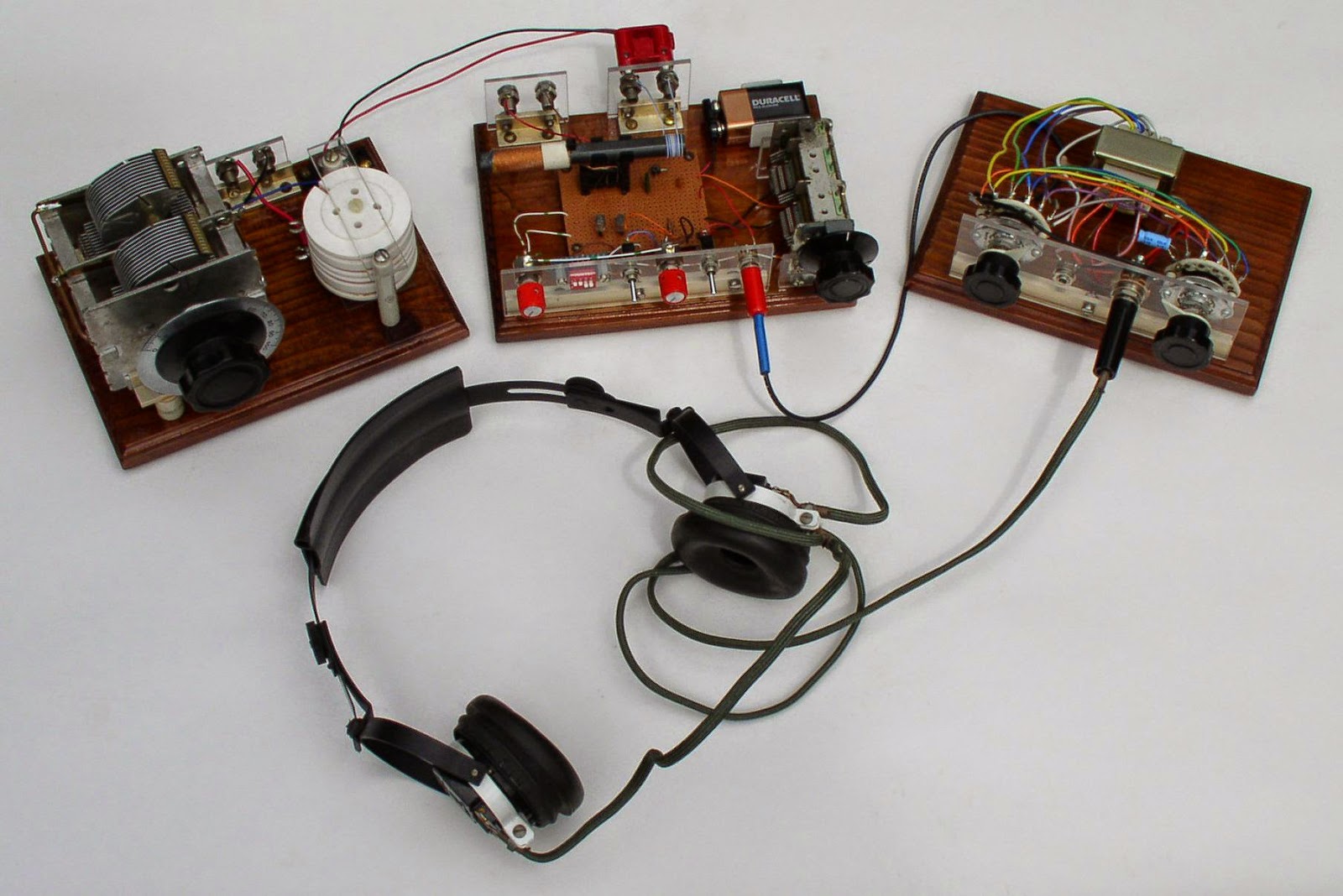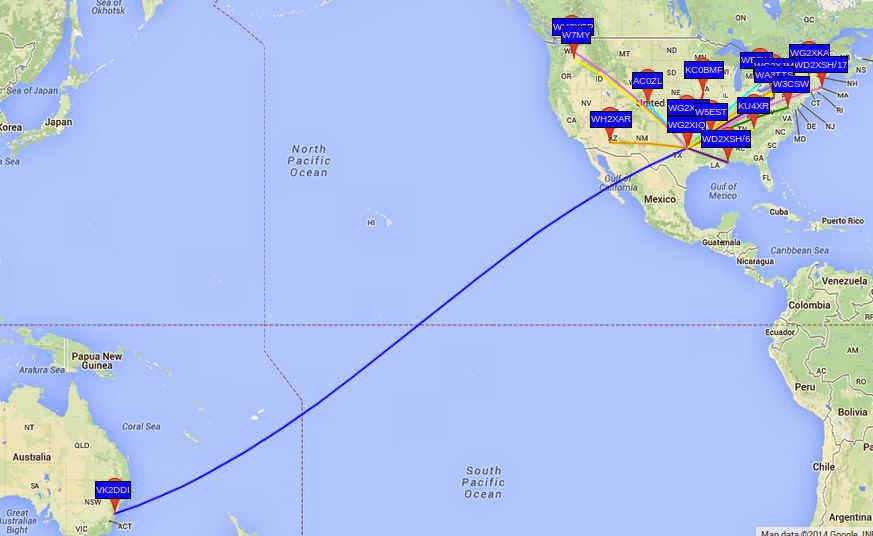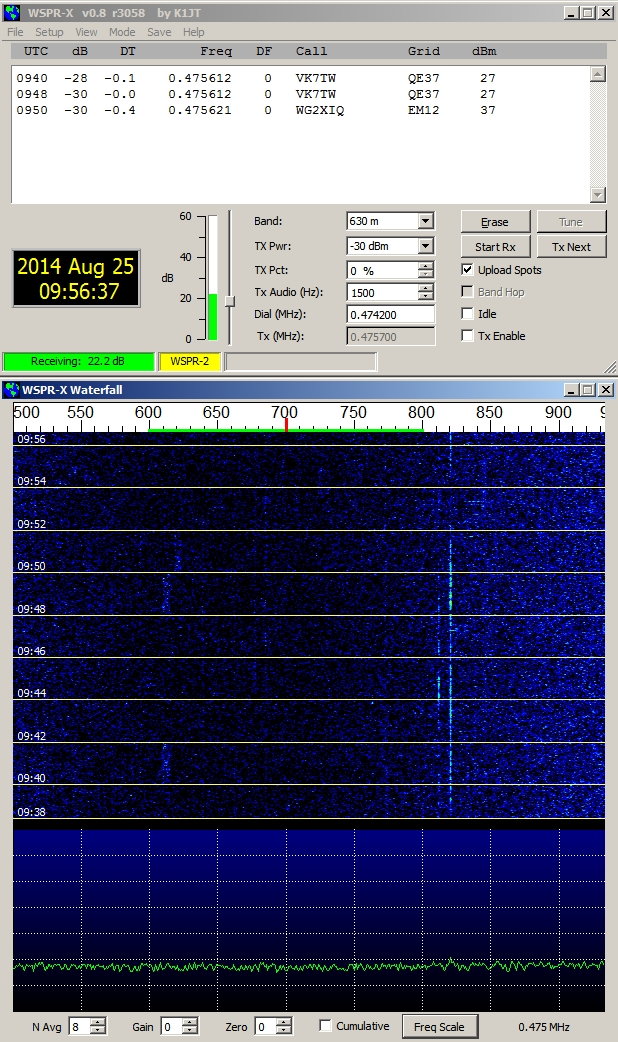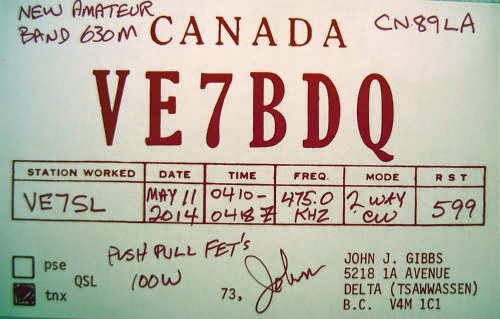Posts Tagged ‘LF’
 A New 630m Loading Coil & Variometer
A New 630m Loading Coil & Variometer
I've decided, for the time being, to keep my 2200m (136kHz) antenna tuning system separate from the 630m system. This means that I'll need to build a new loading coil, variometer and impedance matching transformer. I'm not really sure why I should maintain the 2200m capability since there is not really much activity here. The only two excuses that I have at present are the fact that it took a heck of a lot of work to get to this point (but it was mostly "fun work") and that the U.S. may be getting the band soon. I'm also not convinced that even if the U.S. does get the band that it would translate into much new activity....so, for the time being, I will keep the system intact.
I've used an online coil calculator to design the coils needed for loading and for the variometer....it will be interesting to see how close the finished values compare with the calculated values. I hope they're not too far off! Here is what the plan calls for:
The main loading coil will be built on a low-loss 6" styrene pipe coupler using #16 solid copper transformer wire, spaced at 3mm. The coil will be elevated above the main form by strips of styrene rod that I have filed small notches into, every 3mm. The rod height will be staggered around the form, gradually stepping down one full turn every 360 degrees. Inside the main coil, the smaller variometer coil will be wound with poly-covered #18 stranded wire on a short length 3 1/2" PVC pipe.
Hopefully I'll get something that tunes from 130-230uH, approximately....if so, I'll not only be happy, but really surprised!
 Perseus Alaskan NDB Watch
Perseus Alaskan NDB Watch
 |
| Courtesy: https://www.google.ca/maps/ |
09/09/14 1300 529 SQM Level Island AK CO36
09/09/14 1300 396 CMJ Ketchikan AK CO45
09/09/14 1300 391 EEF Sisters Island AK CO28
09/09/14 1300 372 FPN Fredericks Point AK CO36
09/09/14 1300 266 ICK Annette Island AK CO45
09/09/14 1300 414 IME Mt. Edgecumbe AK CO27
09/09/14 1300 394 RWO Kodiak AK BO37
09/09/14 1300 209 CYT Yakataga AK BP80
09/09/14 1300 390 HBT Sand Point AK AO95
09/09/14 1300 358 SIT Sitka AK CO26
09/09/14 1300 350 VTR McGrath AK BP22
09/09/14 1300 338 CMQ Campbell Lake AK BP41
09/09/14 1300 429 BTS Dillingham AK BO08
09/09/14 1300 233 ALJ Johnstone Point AK BP60
09/09/14 1300 212 CGL Coghlan Island AK CO28
09/09/14 1300 223 AFE Kake AK CO36
09/09/14 1300 229 AKW Klawock AK CO35
09/09/14 1300 283 DUT Dutch Harbor AK AO63
09/09/14 1300 245 HNS Haines AK CO29
09/09/14 1300 347 DJN Delta Junction AK BP74
09/09/14 1300 411 ILI Iliama AK BO29
09/09/14 1300 277 ACE Homer AK BO49
09/09/14 1300 355 AUB King Salmon AK BO18
09/09/14 1300 524 MNL Valdez AK BP61
09/09/14 1300 382 JNR Unalakleet AK AP93
09/09/14 1300 281 CRN Cairn Mountain AK BP21
09/09/14 1300 385 EHM Cape Newenham AK AO88
09/09/14 1300 385 OCC Yakutat AK CO09
09/09/14 1300 263 OAY Norton Bay AK AP84
09/09/14 1300 390 AES Northway AK BP29
09/09/14 1300 404 GCR Cordova AK BP70
09/09/14 1300 525 ICW Nenana AK BP54
09/09/14 1300 251 OSE Bethel AK AP90
09/09/14 1300 341 ELF Cold Bay AK AO85
09/09/14 1300 356 HHM Kotzebue AK AP86
09/09/14 1300 248 GLA Gulkana AK BP72
09/09/14 1300 379 IWW Kenai AK BP40
09/09/14 1300 399 SRI St. George AK AO56
09/09/14 1300 359 ANI Aniak AK BP01
09/09/14 1300 272 UTO Utopia Creek AK BP35
09/09/14 1300 257 CUN Fairbanks AK BP64
09/09/14 1300 227 MHM Minchumina AK BP33
09/09/14 1300 346 OLT Soldotna AK BP40 mod
09/09/14 1300 414 OQK Noatak AK AP87
09/09/14 1300 347 TNC Tin City AK AP65 mod
09/09/14 1300 325 BVK Buckland AK AP95
09/09/14 1300 275 CZF Cape Romanzof AK AP61
Highlighting the morning was my first "new catch" from Alaska in several years - 'SMA' at St. Mary's Lake on 230kHz. It has been on my morning check list for many many years but only today did it decide to reveal itself!
09/09/14 1300 230 SMA St. Mary's AK AP82 USB 231.085 no sign of a LSB
Reported to be running 70 watts, this particular beacon has never been reported to the RNA NDB list nor even heard by those listening in Alaska. I suspect either a very tough path or a system in need of a tune- up. A Google Map view appears to show a single vertical antenna but it may be one end of a 'T' support.
 |
| Courtesy: https://www.google.ca/maps/ |
Hopefully conditions will continue to improve as there are still a few up there that have yet to be logged!
 Smoke Testing The GW3UEP 630m Transmitter
Smoke Testing The GW3UEP 630m Transmitter
 |
| Drain (top) vs Gate (lower) on testbed Class-E GW3UEP TX |
I've just completed the Muppet-styled printed circuit version of my previously breadboarded GW3UEP 630m transmitter. The earlier version was built "ugly style" in order to optimize part values and measure circuit parameters.
 |
| Testbed (Ugly-Style) |
 |
| Final Version (Muppet-Style) |
Running the TX at 12.8VDC on the drain(s) at 2.3A produces an input power of 29W. The measured power out, after the LPF, is 23W into a 50 ohm load. This represents an efficiency of 80%. When run in the normal speed CW mode, the FETs run cool enough that they would probably not even need a heatsink but if run in any of the QRSS (long keydown periods) modes, would certainly benefit from heatsinking.
Running the TX at a higher voltage of 22.6VDC (on the amplifier only) yields a current of 4A for an input of 90W. Measured output power is 71W for an efficiency of 79%.
Heatsinking would be required at this power level, even for normal speed CW but the finals seem to run just slightly warm. A larger heatsink or possibly a small fan as well would be required for any QRSS CW modes.
I suspect that the efficiency could be further improved yet with very fine tweaking of the output circuit L/C network but the extra few watts gained would not be significant.
At either power level, this easy-to-build transmitter would make a great "first 630m transmitter" for anyone wanting to get started on our new band.
 Tuggle-Style LF Regens
Tuggle-Style LF Regens
 If the name sounds familiar, you may recognize it from reading about the DX crystal radios that Mike Tuggle has created over the past several years. Some might even say that his state-of-the-art and very elegant "Lyonodyne 17" crystal radio re-kindled the modern day interest in crystal radio DXing, once the mainstay of all radio adventures.
If the name sounds familiar, you may recognize it from reading about the DX crystal radios that Mike Tuggle has created over the past several years. Some might even say that his state-of-the-art and very elegant "Lyonodyne 17" crystal radio re-kindled the modern day interest in crystal radio DXing, once the mainstay of all radio adventures. |
| Mike Tuggle's Lyonodyne 17 Crystal DX Tuner |
I'm not sure what sparked Mike's interest in building regens but it may go back several years to the "1AD" contest sponsored by the Birmingham Crystal Radio Group. This was a DX contest challenge that allowed a receiver to use only "1 Active Device", as explained in the rules:
"Only one active device is allowed to be counted to get the 1AD bonus points. The device can be a bipolar, FET, tunnel diode or tube (triode, tetrode, pentode, or heptode), but only one device may be used. If a tube envelope has more than one tube in it, use only one of those active devices to be counted as a 1AD. Crystal sets may be used if one active device is added either inboard or outboard. Totally passive crystal sets are not allowed. In the active set, any number of diodes (either solid state or tube diodes) may be used; however, a tunnel diode or similar active device counts as the 1AD for the contest.
The use of integrated circuits can be interesting in that one IC can be used to build a full superhet. The use of an IC means that the set will not qualify for the 1AD nor for the 2AD bonus points."The challenge was too hard to resist for many and the contest was popular for several years running. Some of the inventive entries for individual years may be seen here. The contest logbooks also make for interesting reading and demonstrate the capability of some of these simple radios.
Although the contest has not been run for the past few years, there is still much interest and discussion of "1AD" radios on Dave Schmarder's "RadioBoard" forum.
Mike's LF tuner is a prime example as he uses it daily and continues to post some amazing DX to the Yahoo "ndblist" Group. His furthest ndb catch in North America with the regen has been "YY" in Mont Joli, Quebec.
Now, "YY" is a good catch for me, from B.C., but Mike is listening from Kaneohe, Hawaii !
You can read about Mike's original design here, while his latest version shown below, incorporates a dedicated LF antenna tuner.
 |
| LF Regen (Courtesy Mike Tuggle) |
 |
| LF Regen Schematic (courtesy Mike Tuggle) |
 |
| Courtesy: Roelof Bakker, PAØRDT |
Roelof has also published a nice write-up describing the project which sparked a lot of "must build" discussion within the group.....even enough to make Mike get out his soldering iron and build the European-version!
As old and as simple as they are, regenerative receivers still hold much fascination amongst radio builders and dollar-for-dollar are amazingly good performers, especially on LF.
 630m Trans-Pacific WSPR
630m Trans-Pacific WSPR
 |
| Courtesy: https://www.google.com/maps/ |
This is particularly noteworthy in view of the relatively low power used for John's beacon....around 200W. With the typical backyard antennas being used at these frequencies, efficiencies are very low and John's actual ERP is less than 5W. The transpacific reception of John's signal by VK2DDI confirms what most LF'ers already know....that small suburban lot amateur installations can have positive results on 630m without the need for huge antenna systems.
The WG2XIQ beacon was operating in the WSPR mode, which has become very popular amongst 630m experimenters as well as those just interested in listening-in. WSPR is not a QSO mode but strictly a one-way 'beacon' mode. Although two stations may each spot each other, it is not considered to be a valid two-way QSO. A check of evening WSPR activity will often reveal dozens of stations actively spotting what they are hearing.
Like most LF stations, John's is mostly homebrew.
| WG2XIQ/KB5NJD |
I'll let him describe the details:
"I have a few ways of making RF in the shack. I can do CW with a very nice waveform using the GW3UEP VFO/Driver coupled with a GW3UEP 100w amp with waveform shaping. The other way is via the MF Solutions transmit downconverter, developed by John Molnar, WA3ETD/WG2XKA. I have two of those boards, one is a backup. I use a GPSDO for the LO and use that signal to drive two parallel GW3UEP amps with max power at 125 watts each. The W1VD Ø degree hybrid combiner brings them together in phase for close to somewhere between 200 and 250 watts TPO depending on how hard I drive and how close I match the TX levels entering the combiner. I filter the output with the W1VD KW LPF that was built by Dave Robinson G4FRE (ex WW2R). I power the amps with a pair of BK Precision 30V 6Amp variable power supplies (variable current limit threshold also). Scope match is used to resonate and match the the impedance. IF Rig on 630m is typically a Yaesu FT920. These days RX antennas are the VE7SL multiturn loop or the TX vertical, both of which have their own merits depending on the conditions at the time."
| John's 630m Vertical |
"Antenna is an 80 foot asymmetric T-top marconi with 100 foot and 200 foot legs....radial system is almost 3 miles of radials connected via various busses. 26 ground rods around the property. I monitor current in the shack and sample via a Bauer current transformer from an AM BC ATU."
| 630m Radial System |
John's system does indeed work well...just last year at this time, his 630m signals were copied by KL7L near Anchorage, Alaska.
Of course, equal credit must be given to VK2DDI for having a system good enough to hear John's signal all the way down on Berry Mountain, New South Wales, Australia! It is there that David has set up a fine LF station, 500m above and overlooking the Tasman Sea...an ideal location for weak-signal LF work.
 | ||||
| VK2DDI - Berry Mountain, NSW |
 | ||
| WG2XIQ Signal As Heard in VK |
David also runs the Berry Mountain Grabber, providing other VK and ZL experimenters a handy way of checking their system progress or propagation conditions.
If you have been doing any WSPR work on HF, you might be surprised at what you can hear down on 630m, even without a dedicated antenna for that band. Surprisingly good results can often be had with a non-resonant antenna as the signal to noise ratio can often be better even though signals may sound weaker. Give it a try and spot what you hear!
If you are interested in learning how to receive WSPR, here is a nice tutorial by ZS6SGM.
Should you be interested in knowing more about obtaining a Part 5 licence to transmit on 630m, John will happily guide you through the process. He can be contacted via email or you can find him hanging-out most nights on the ON4KST kHz (2000-630m) chat page.
To keep on top of what is happening or who is on-the-air, most LF'ers rely on three sources:
- the RSGB LF Group reflector
- the Lowfer list
- the LWCA Message Board
 Alaska’s NDBs Awaken!
Alaska’s NDBs Awaken!
 |
| Courtesy: http://www.alaskacooling.com |
This past weekend saw another of the monthly "Co-ordinated Listening Event" (CLE) activities sponsored by the Yahoo ndblist Group and organized by Brian Keyte, G3SIA. This is a group of dedicated low frequency NDB DXers that enjoy hunting down new catches as well as keeping track of NDB activity in general. These low powered beacons make excellent propagation indicators and are always a good measure of one's LF receive capability.
As often happens, the monthly events seem to coincide with poor propagation periods for some unexplainable reason, as was the case once again. As well as the generally poor propagation, North America was plagued with high levels of lightning activity making any weak signals very difficult to hear through the steady din of QRN.
In spite of the poor conditions, two nice catches from Alaska (ELF and TNC) heralded the fast receding midnight-sun in the 49th state and the start of another Alaskan NDB DX season!
The NDB at Cold Bay is 'ELF' and transmits on 341kHz. Cold Bay is located on the Alaskan Peninsula, at the top of the Aleutian chain.
 |
| Courtesy: http://pics3.city-data.com |
Built as a military airfield in WWII, Cold Bay's traffic is now mostly cargo and its long runway serves as an emergency 'alternate' for flights in the north Pacific.
A search of Google Maps shows the NDB itself is located several miles north of the airport and appears to use a large vertical and an extensive ground system. With the transmitter power listed as 1000W, ELF makes an excellent target for DXers looking for their first Alaskan NDB.
 |
| Source: https://maps.google.ca |
 |
| Source: https://maps.google.ca |
Like 'ELF', the antenna appears to be a vertical but possibly of smaller size.
 |
| Source: https://maps.google.ca |
For ELF, listen on 342.030kHz or 339.968kHz. The carrier will be on 341.0kHz.
For TNC, listen on 348.034kHz or 345.968kHz. The carrier will be on 347.0kHz.
For a list of all active NDB's in Alaska, complete with accurate frequency-spotting information, visit the beacon-reporting RNA website. Put 'AK' in the 'States' window and pick 'All Results' in the 'Show' window. There are presently at least 60 or more NDBs known to be operational in Alaska.
As mentioned before, please exercise caution should you decide to jump-in...chasing NDBs can quickly become addictive as anyone in the 'ndblist' Yahoo Group will tell you.
On the other hand...Alaska is waiting!
 ‘CQ Crossband’ – 630m
‘CQ Crossband’ – 630m
.jpg) |
| First 630m contacts |
In early May, VE7BDQ (John) was my first contact on our new 630m amateur band! Soon after, I had QSO #2, with VA7JX (Jack), on Vancouver Island. So far there appears to be only one other station in Canada on the band... VO1NA in Newfoundland!
Where are the rest of the Canadians? It's not too late to be the 1st VE6, VE5, VE4, VE3, VE2 or VE1 on the new band!
Hopefully there will be more stations active before the winter DX season gets underway!
In an attempt to keep my own interest level up as well as trying to get the word out to others about our new band, I've completed crossband contacts with three other VE stations. Two of the contacts were on Vancouver Island....VE7DAY (John) in Campbell River and VA7FC (Perry) in Courtenay. The third station was VE6TA (Grant), near Edmonton, Alberta. A fourth crossband contact was completed when I worked W7WKR (Dick) near Lake Chelan in Washington state. John, VE7BDQ, also completed crossband contacts with VE6TA and W7WKR giving those two stations a 'VE7 two-fer'.
Both John and I would love to do a lot more crossband work, especially with stations in the U.S.A. who presently cannot transmit on the band but may still be very much interested in 630m. A recent overnight beaconing session at 25 watts output clearly indicated that under fairly normal conditions and with a good receiving system on 630m, my normal speed CW signal can cover a wide geographic area during the hours of darkness. Having up to 500 watts of power available for CW, my signals should have good coverage to all of the western and central states at this time of the year.
Such crossband type contacts are perfectly legal between any and all stations in the "amateur radio service" and at one time, this was the only mode available between Europe and North America on the 50MHz band, as this tantalizing review of Cycle 19's amazing propagation explains.
If anyone, anywhere (both U.S. or VE), would be interested in attempting a crossband CW QSO, I would love to try! Please contact me via the comments section below or via e- mail.
I would also be interested in hearing from any Canadians who are planning to get on the new band as I am trying to keep track on my website's LF page.





.jpg)












